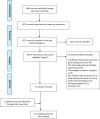Use of technology in supporting goal setting in rehabilitation for adults: a scoping review
- PMID: 33172946
- PMCID: PMC7656911
- DOI: 10.1136/bmjopen-2020-041730
Use of technology in supporting goal setting in rehabilitation for adults: a scoping review
Abstract
Objective: To map the extant literature evaluating the use of technology for goal setting in adult rehabilitation and the impact of technology for patient outcomes.
Design: Scoping review.
Methods: MEDLINE (via Ovid), CINAHL (via EBSCO), AMED and Scopus were searched for articles describing observational or interventional studies. ProQuest Dissertations and Theses database were searched for grey literature. Two review authors independently screened all titles and abstracts for potentially relevant articles. We included articles describing studies that had evaluated the development or application of technology to facilitate goal setting in rehabilitation for adults. Articles were excluded if the technology described did not include features to facilitate goal setting or were not in English. Narrative reviews, opinion pieces and editorials were also excluded.
Results: After screening 1640 publications of potential interest, we identified 27 studies for inclusion. These 27 articles described studies involving a total of 16 different technologies including, seven mobile apps, three websites, two mobile apps/website hybrids, two apps and two websites connected to a pedometer. We found that most technologies described were designed to facilitate self-management with goal setting as a feature and that only five included a shared decision moment around goal setting. Only six of the 16 technologies had research providing evidence of effectiveness in terms of improved patient outcomes, with the best evidence of beneficial effects associated with technologies that linked goal setting to pedometer use.
Conclusions: The identified technologies for use in adult rehabilitation that included goal setting as a feature were largely accepted and valued by patients and health professionals. The limited data suggest that there is a need for further research; specific foci may include the impact of incorporation of a shared decision-making moment and evaluation of effectiveness on patient outcomes.
Keywords: health informatics; information technology; rehabilitation medicine.
© Author(s) (or their employer(s)) 2020. Re-use permitted under CC BY-NC. No commercial re-use. See rights and permissions. Published by BMJ.
Conflict of interest statement
Competing interests: None declared.
Figures
References
-
- Siegert RJ, Levack WMM. Rehabilitation goal setting: theory, practice and evidence. CRC press, 2014.
-
- Barnes M, Ward AB. Textbook of rehabilitation medicine. Oxford, USA: University Press, 2000.
-
- Levack WM, Weatherall M, Hay-Smith JC, et al. . Goal setting and strategies to enhance goal pursuit in adult rehabilitation: summary of a Cochrane systematic review and meta-analysis. Eur J Phys Rehabil Med 2016;52:400–16. - PubMed
Publication types
MeSH terms
LinkOut - more resources
Full Text Sources

